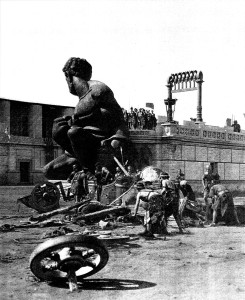Everyone understands the desire of artists to reach thrilling new peaks in art and entertainment. All of us who love motion pictures and show business in general can understand why stunt men and rodeo riders and circus performers put their lives on the line for a breathtaking stunt; and why filmmakers might risk life and limb to go trekking out onto frozen lakes and parched deserts to capture a cinematic vision.
If most people stopped to think about it, they might even understand why a movie mogul would bet his whole film studio and reputation on some jinxed, big-budget long-shot like an epic movie version of “Ben-Hur.”
But what happens if things start going disastrously wrong? What happens when the risks begin to overshadow the goal and it’s no longer just the hired stunt men and ambitious participants paying the price for achieving that “artistic vision”?
That is what “The Ben-Hur Murders” is really about — that moment when the hopes of show-business glory run smack up against one’s moral conscience. It is about the emotional crisis that arises when one’s personal sense of honor is challenged by the sight of real injury and death.

Do you swallow your guilt for some future day of atonement and drum up your own tidy rationalizations? Do you forge ahead and allow yourself to be implicated in tragedy in order to achieve your objective?
That is the larger, darker meaning of my title. It is the suffocation of innocence, the sacrifice of idealism and the acceptance of guilt as the price of success. In a thematic sense, it is the truth from “Inside the 1925 Hollywood Games.”
Don’t misunderstand. There are also real human murders in my novel, the sort that require police investigation and demand criminal justice. But they are largely made up, and are merely the fictional engine that drives my narrative.
Along the way there are also well researched accounts of long-whispered rumors of drownings, fatalities, horses’ deaths and other disasters in the making of “Ben-Hur,” They al loom very large in the lore and legend of early Hollywood.
But the bulk of “The Ben-Hur Murders” is set on that single day in 1925 when MGM executives staged the great “Ben-Hur” chariot race on a back lot in Culver City. Are the chariot crashes that occurred that day mere accidents or deadly acts of sabotage?
Among the implicated:
Production chief Irving G. Thalberg. Surely the shock of the accidents on the track and the piling up of the fallen horses presented him with a philosophical dilemma. As MGM’s vice president in charge of production, Thalberg had arranged the shoot, ordered the construction of the replica of the Antioch coliseum, sent out the engraved invitations to all of Hollywood’s elite. He was in a position to stop the slaughter, even though doing so would have meant the almost certain end of the promising new MGM studio.
What about the famous movie stars and rising directors watching from the VIP section of the stands? Perhaps they shared the reaction of MGM’s reigning screen beauty Norma Shearer. She abhorred what was happening down on the track but she knew that raising an objection would be tantamount to ending her own promising screen career.
Most painfully there were the cowboy stunt drivers and rodeo riders down on the track. Surely they cared more about the lives of their horses than all of Hollywood and its phony, showbiz promises. But what could they do when their options came down to providing for their families or firing a fatal bullet into the brain of a fallen beloved pony?
Yes, there were deaths on the track that day — both real and fictional. But the lasting damage of “The Ben-Hur Murders” was personal and private. Its true costs will never be weighed.
(c) 2016. John W. Harding


Leave a Reply